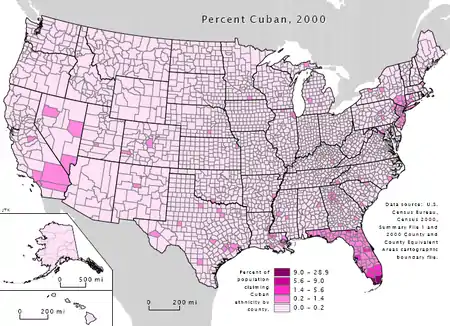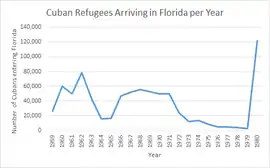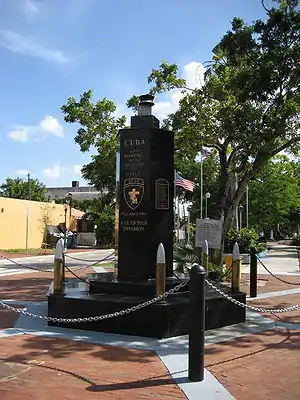Cuban migration to Miami
Cuban immigration has greatly influenced modern Miami, creating what is known as "Cuban Miami." However, Miami reflects global trends as well, such as the growing trends of multiculturalism and multiracialism; this reflects the way in which international politics shape local communities.[1]

| History of Florida |
|---|
 |
|
|
About 500,000 Cubans, most of them business people and professionals, arrived in Miami during a 15-year period after the Cuban Revolution. Some figures in Fulgencio Batista's administration were among those who arrived in Miami. The Miami Cubans received assimilation aid from the federal government. The Cubans established businesses in Miami. The Cubans arriving after 1980 did so primarily because of economic reasons.[2]
Essentially, the coexistence of growth and internationalization within Miami has perpetuated an ethnically driven social polarization.[3] The growing number of Cubans in Miami have remained loyal to their cultural norms, mores, customs, language, and religious affiliations. The transnational force of immigration defines Miami as a growing metropolis, and the 20th century Cuban influx has greatly affected Miami's growth.[1]
As of 2012, there were 1.2 million people of Cuban heritage in Greater Miami. As of that year, about 400,000 had arrived after 1980.[2]
History

Early migration (1800s - 1958)
Due to Miami's geographic proximity to Cuba it served as an easy location to migrate to for Cubans who were dissatisfied with poverty, or the various military dictatorships in Cuba. Many affluent Cuban families also sent their children to school in the United States, usually in Miami. Various Cuban political leaders used Miami as a base of operations to organize against the Fulgencio Batista regime.[4]
By 1958 only about 10,000 Cubans lived in Miami, while various affluent Cubans would often visit Miami, even just for the day. The tourist industry in Miami heavily catered to Cuban visitors and tried to offer as many services in Spanish as possible.[4]
First Cuban exiles (1959 - 1973)
After the Cuban Revolution of 1959 various Cubans began to leave the country. Cubans settled in various places around the United States but many settled in Miami due to its proximity to Cuba and Cuban culture already in the city. Many would live in the neighborhoods of Little Havana or Hialeah, Florida in Miami due to their cheap housing, new jobs, and sometimes their access to Spanish speaking businesses.[5]
As Cubans became more settled in Miami more businesses and media outlets began catering to Spanish speaking audiences. Many non-Hispanic locals began moving out of Miami in a white flight.[5]
Cuban immigration greatly affected Miami's future demographics. For example, the net immigration of African Americans into Miami was reduced during the 1960s in comparison to previous years.[6] This was the result of Cuban immigrants competing for jobs that had often been afforded to African Americans living in Miami. This reduction of immigration of non-Hispanics displayed the growing presence of Cubans in Miami. Miami "posts a low emigration rate-43.6 per 1,000. This, of course, stems from the huge Cuban presence in Dade County and is testimony to the holding power of the Cuban enclave in Miami".[7]
Later exiles and migrants (1974 - )
By 1980 many Cubans arrived in the United States due to the Mariel boatlift. But other Cubans already in the United States began to enter south Florida. Miami posted an in-migration of 35,776 Cubans from elsewhere in the United States between 1985 and 1990 and an emigration of 21,231, mostly to elsewhere in Florida. Flows to and from Miami account for 52 percent of all interregional migration in the Cuban settlement system".[7]
Cubans continued to come to the United States and specifically Miami, especially during the 1994 Cuban rafter crisis and beyond. As Cubans continued to immigrate and become more settled in American society, many Cuban owned businesses began to prosper in the Miami area.[5]
Culture

Language
With the emerging importance of ethnicity and the increased effects of segregation, Cubans within Miami attempted to reassert the Spanish language. In Miami, the Spanish language was spoken to a larger extent than in other cities with large Hispanic populations; also it was spoken in more diverse settings in Miami than any other city.[1] The 1970 census revealed that Spanish speakers made up 24 percent of Miami's population.[6] The Spanish language was becoming a norm in Miami as it was more extensively spoken by Miami's Cuban elite.[1] Language became increasingly important in 20th-century Miami as a result of the Cuban influx and this had impacts on other non-Latin communities.
Non-Hispanic communities began to oppose the rise of the Spanish language as a growing force within Miami. This can be seen in the anti-bilingualism/English Only movement. This movement came about in 1980, after a long period of vast Cuban immigration and social reform. Language was becoming a pressing issue as "Miami had the first bilingual public school program in the modern period (1963) and the first English Only referendum (1980)".[8] In fact the debates of English as Dade County's official language led to violent and dangerous riots in the 1980s.[9] Cubans felt that by preserving their language, they were preserving a fundamental component of their culture. In the 2000 census, 59.2% of people in Miami-Dade County said that they spoke Spanish at home.[10]
Media
Although the media in Miami allows a certain amount of cultural labeling to flourish within the community, it also portrays the growing importance and domination of Cuban immigrants. For example, the Miami Herald's June 14, 1996 headline reads "Vanishing Spanish".[3] The headline refers to, and deplores the fact that, only a small percentage of recent high school graduates were fluent in Spanish; whereas the majority of second-generation Cuban immigrants spoke broken Spanish, and only spoke it in the home.[3] "This was described as an alarming trend since it erodes Miami's advantage as a bilingual community and diminishes its economic competitiveness".[3] During the 20th century, many Spanish-language newspapers were founded in Miami. "The Miami Herald created a Spanish-language insert, el Nuevo Herald, in 1976".[11] This addition received a vast amount of support and "by 1981 circulation reached 83,000 on weekdays and 94,000 for weekend editions. el Nuevo Herald is now published as an independent newspaper and reports a weekday circulation of about 100,000. It too is accessible on the World Wide Web (http://www.elnuevoherald.com). As the Hispanic population has grown and achieved considerable economic success, it has also moved beyond Miami's city limits: Spanish-language newspapers are now published in adjacent Hialeah and Fort Lauderdale. This expansion can be seen at a statewide level as well, for Tampa, Orlando, and Immokalee each have Spanish-language newspapers".[11] Essentially, through the founding and growth of distinctly Hispanic newspapers, Cuban immigrants established a distinctly Latin American media.
Politics
Historically the Miami Cuban community has strongly opposed Fidel Castro and has blocked normalization in Cuba-United States relations. The Cubans arriving after 1980 have closer ties to those remaining in Cuba. They tend to take charter flights to and from Miami to Cuba.[2]
In Miami-Dade County, in the 2020 election, Cuban Americans tended to vote for Donald Trump.[12] Residents of Cuban descent often had an antagonism against leftist movements due to associations with Fidel Castro.[13] Trump sought to attract these voters by implementing anti-Cuba policies.[14] The courting of Miami Cubans, including those who had recently arrived in the U.S. and those who are of younger demographics, contributed to Trump taking Florida's electoral votes.[15] Miami-Dade County as a whole normally leans Democrat, but Trump's performance among Cubans overall eroded that.[16]
Parks and recreation
As common meeting places, several parks in the greater Miami area reflect the influence of Cuban migration to the community and nod to Cuban culture.
Starting in the early 1970s, community leader and urban planner Jesus Permuy spearheaded the effort to designate a park for the Cuban exile community.[17] The sometimes controversial proposed park was known for much of the almost ten-year effort simply as the "Latin Park," and faced some pushback from non-Cuban residents. The park was unanimously approved by the Miami City Commission, however, and finally opened in 1980[18] as José Martí Park in honor of Cuban icon José Martí.
Another noteworthy park named after a popular Cuban figure is Máximo Gómez Park, named after Máximo Gómez.[2] Additionally, other parks feature monuments and landmarks in honor of Cuban figures, such as the "MINOSO" sculpture in Miami Lakes' Optimist Park by Cuban artist Rafael Consuegra that was erected in honor of Cuban baseball player Minnie Minoso.
See also
- Operation Peter Pan, 1960-1962
- Hispanic and Latino Americans in Florida
- Immigration to the United States
- El Nuevo Herald, a Spanish-language supplement to The Miami Herald
- Wet feet, dry feet policy
- Cuban-American lobby
References
- Stack, John F. Jr. (1999), "The Ethnic Citizen Confronts the Future: Los Angeles and Miami at Century's Turn", The Pacific Historical Review, 68 (2): 309–316, doi:10.2307/3641990, JSTOR 3641990
- "Cuban-Americans The Miami mirror." The Economist. March 24, 2012. Retrieved on February 8, 2014.
- Nijman, Jan (1997), "Globalization to a Latin Beat: The Miami Growth Machine", Annals of the American Academy of Political and Social Science, 551 (1): 164–177, doi:10.1177/0002716297551001012, S2CID 154895047
- Levine, Robert; Asis, Moises (2000). Cuban Miami. Rutgers University Press. ISBN 9780813527802.
- Garcia, Maria (1996). Havana USA: Cuban Exiles and Cuban Americans in South Florida, 1959-1994. University of California Press. ISBN 9780520919990.
- Winsberg, Morton D. (1979), "Housing Segregation of a Predominantly Middle Class Population: Residential Patterns Developed by the Cuban Immigration into Miami, 1950-74", American Journal of Economics and Sociology, 38. 403-418
- Skop, Emily H; Miyares, Ines M; Skop, Emily H (1997), "The Magnetism of Miami: Segmented Paths in Cuban Migration", Geographical Review, American Geographical Society, 87 (4): 504–519, doi:10.2307/215228, JSTOR 215228
- Castro, Max, J. (1992), "The Politics of Language in Miami", Miami Now: Immigration, Ethnicity, and Social Change (University Press of Florida): 109-133
- Croucher, Sheila, L. (1999), "Ethnic Inventions: Constructing and Deconstructing Miami's Culture Clash", The Pacific Historical Review, 68: 233-251
- 2000 US Census Archived 2020-02-12 at Archive.today Profile of selected social characteristics for Miami-Dade County
- Huntz, Maura E. (1996), "Spanish-Language Newspapers in the United States", Geographical Review, 86: 446-456
- Viteri, Amy; Torres, Andrea (2020-11-06). "Presidential election: Here is why eastern Miami-Dade is celebrating and western Miami-Dade is not". Local 10 Miami. Retrieved 2020-11-08.
- "Cuban Americans show strong support for Trump". University of Miami. October 2020. Retrieved 2020-11-08.
- Gomez Licon, Adriana (2020-10-30). "With salsa, caravans, Cubans make last push to reelect Trump". Associated Press. Retrieved 2020-11-08.
- "How Miami Cubans disrupted Biden's path to a Florida win". Politico. 2020-11-04. Retrieved 2020-11-08.
- Ceballos, Joshua (2020-11-05). "Experts Weigh in on Miami-Dade's Role in Trump's Florida Victory". Miami New Times. Retrieved 2020-11-08.
- Ed Taylor, "Miami OKs 'Latin' Park Site", The Miami News (April 27, 1973), p. 16A.
- Eric Rieder (January 12, 1980). "Design Chosen for Latin Park". The Miami Herald. pp. 2B. Retrieved October 8, 2018.
Further reading
- Arboleya, Jesús. Havana-Miami: The U.S.-Cuba Migration Conflict. Ocean Press, 1996. ISBN 1875284915, 9781875284917.
- De La Torre, Miguel A. La Lucha for Cuba: Religion and Politics on the Streets of Miami. University of California Press, 2003. ISBN 052093010X, 9780520930100.
- Levine, Robert M. and Moisés Asís. Cuban Miami. Rutgers University Press, 2000. ISBN 0813527805, 9780813527802.
- Rieff, David. Exile: Cuba in the Heart of Miami. Simon & Schuster, February 19, 2013. ISBN 1439143706, 9781439143704.

